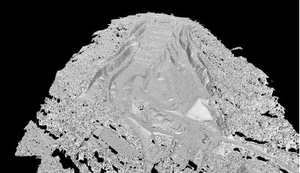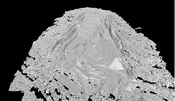Information
- Publication Type: Bachelor Thesis
- Workgroup(s)/Project(s):
- Date: September 2022
- Date (Start): 12. January 2022
- Date (End): 15. October 2022
- Matrikelnummer: 11808210
- First Supervisor: Michael Wimmer

Abstract
As the accessibility of high-quality 3D scans increases, processing the scanned data becomes more challenging. 3D scanners obtain very large, unstructured sets of points,
so called point clouds. To be able to use the data in a meaningful way it is necessary to reconstruct the surface of the scanned object from the point cloud, resulting in a 3D
model. This is called the problem of 3D surface reconstruction. Processing very large point clouds (in a reasonable time) is necessary in order to keep up with ever increasing scanning technology.
In this thesis, we construct, implement and evaluate a distributed surface reconstruction algorithm called DistributedBallFilter. It is a distributed-memory parallel version of the recently developed BallFilter algorithm [Ohr22]. Firstly, the input point cloud is subdivided into chunks called tiles using a 3D grid. To ensure the correctness of the results, tiles are slightly overlapping on their borders. After splitting the input, each tile can be processed independently from each other. The tiles are assigned and distributed to a number of p processes. The assignment of tiles to processes is calculated using longest-processing-time-first list scheduling. Then all processes reconstruct the 3D surface of all their assigned tiles in parallel. After all tiles are processed, the result is merged back together into a single 3D model, containing the reconstructed surface of the entire input point cloud. The asymptotic run time complexity is O(n log n) in the worst case (same as BallFilter) and O(n + n log n p ) in the best case, depending on the distribution
of points within the input data.
Furthermore, we implemented the algorithm in C++. The input splitting is run on a GPU using CUDA and discussed thoroughly in its dedicated paper [Bru22]. For each tile a single file is output, which is communicated to each process via a distributed file system. The MPI standard is used for sending all local results to a single process, which is also responsible for merging and outputting the final 3D model.
Finally we executed the algorithm on the VSC3+ cluster, a high-performance cluster based in Vienna. It was run against several test data sets. We visualize the results and analysed the behavior of the running time when scaling the number of processes as well as the input size. In our tests, DistributedBallFilter managed to be up to around
five times faster than BallFilter depending on the number of nodes used and the input size. The largest observed speedup was by a factor of 5.89 compared to BallFilter.
Additional Files and Images
Additional images and videos
Additional files
Weblinks
No further information available.
BibTeX
@bachelorsthesis{Komon2022,
title = "Distributed Surface Reconstruction",
author = "Patrick Komon",
year = "2022",
abstract = "As the accessibility of high-quality 3D scans increases,
processing the scanned data becomes more challenging. 3D
scanners obtain very large, unstructured sets of points, so
called point clouds. To be able to use the data in a
meaningful way it is necessary to reconstruct the surface of
the scanned object from the point cloud, resulting in a 3D
model. This is called the problem of 3D surface
reconstruction. Processing very large point clouds (in a
reasonable time) is necessary in order to keep up with ever
increasing scanning technology. In this thesis, we
construct, implement and evaluate a distributed surface
reconstruction algorithm called DistributedBallFilter. It is
a distributed-memory parallel version of the recently
developed BallFilter algorithm [Ohr22]. Firstly, the input
point cloud is subdivided into chunks called tiles using a
3D grid. To ensure the correctness of the results, tiles are
slightly overlapping on their borders. After splitting the
input, each tile can be processed independently from each
other. The tiles are assigned and distributed to a number of
p processes. The assignment of tiles to processes is
calculated using longest-processing-time-first list
scheduling. Then all processes reconstruct the 3D surface of
all their assigned tiles in parallel. After all tiles are
processed, the result is merged back together into a single
3D model, containing the reconstructed surface of the entire
input point cloud. The asymptotic run time complexity is O(n
log n) in the worst case (same as BallFilter) and O(n + n
log n p ) in the best case, depending on the distribution of
points within the input data. Furthermore, we implemented
the algorithm in C++. The input splitting is run on a GPU
using CUDA and discussed thoroughly in its dedicated paper
[Bru22]. For each tile a single file is output, which is
communicated to each process via a distributed file system.
The MPI standard is used for sending all local results to a
single process, which is also responsible for merging and
outputting the final 3D model. Finally we executed the
algorithm on the VSC3+ cluster, a high-performance cluster
based in Vienna. It was run against several test data sets.
We visualize the results and analysed the behavior of the
running time when scaling the number of processes as well as
the input size. In our tests, DistributedBallFilter managed
to be up to around five times faster than BallFilter
depending on the number of nodes used and the input size.
The largest observed speedup was by a factor of 5.89
compared to BallFilter.",
month = sep,
address = "Favoritenstrasse 9-11/E193-02, A-1040 Vienna, Austria",
school = "Research Unit of Computer Graphics, Institute of Visual
Computing and Human-Centered Technology, Faculty of
Informatics, TU Wien ",
URL = "https://www.cg.tuwien.ac.at/research/publications/2022/Komon2022/",
}


 Bachelor thesis
Bachelor thesis Image
Image
